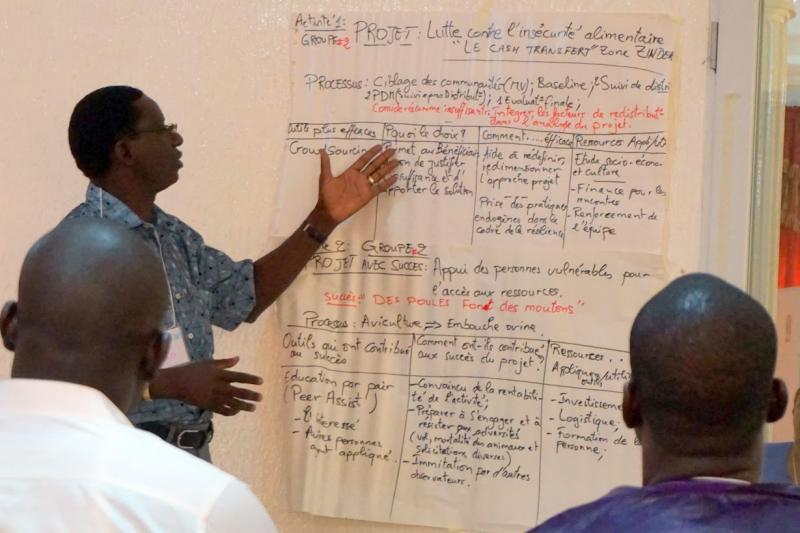The Importance of Champions: A Change Management Manifesto
This may sound painfully obvious, and yet, I feel it warrants articulating—it is the individuals who make up our institutions that either maintain the status quo or create change. The people. They either decide to work in certain ways, or don’t. There is no whimsical, mystical force at play. It comes down to the decisions they make and behaviors they exhibit day in, day out.

It also goes without saying (and yet again, I’m saying it), they exist within an organizational context that either enables or inhibits their willingness to create change. In our work on LEARN, we think a lot about what enables a USAID mission or implementing partner to collaborate, learn, and adapt more systematically. For example, why is there a USAID/Uganda that has very intentionally integrated collaborating, learning, and adapting (CLA) into how it achieves results? How did that come to be? (For examples of how USAID/Uganda has integrated CLA into their work, see here, here, and here. Oh, and here, too.)
What we find each time is there are people—or what we call champions—in the right place at the right time in the right positions and in the right amount to create a tipping point for sustained organizational change.
So who are these champions? What do they do? And how do we create and support more of them?
What do Champions for Collaborating, Learning, and Adapting Look Like?
The Collaborating, Learning, and Adapting (CLA) team at USAID and LEARN have worked with hundreds of CLA champions within the Agency and implementing partners. We consistently reflect on the behaviors champions exhibit to better understand what makes them champions. Here is what we’ve come up with:
| CLA Champions: What do they do? | |
| Promoters | These individuals advocate with other colleagues for CLA integration. They “talk the talk” and build relationships to proactively connect stakeholders to collaborate, learn, and adapt. |
| Integrators | These individuals build collaborating, learning, and adapting into their work and Program Cycle processes, and are thus willing to make time for CLA. By being practical and realistic, a CLA champion is not discouraged by constraints and finds new paths for integrating CLA. |
| Modelers | These individuals “walk the talk” by modeling CLA behaviors and values in how they work and interact with others. They share CLA successes and challenges and become reliable resources for other potential or actual champions. |
There are also potential champions, and this likely constitutes a huge portion of staff working in international development. What are the constraints these potential champions face? A major one is time; they find themselves overworked and unable to make the space needed for more intentional collaborating, learning, and adapting. We have heard especially from USAID mission staff that the opportunity to reflect is a luxury.
“If missions aren't doing CLA, why? The answer is always time and too many demands. We need to look at the full range of responsibilities that people have and make sure that they have the time and space to do what is important.” - USAID Mission staff member
They also may not be familiar with collaborating, learning, and adapting tools and approaches that can help them do their jobs and, therefore, are unsure how to operationalize CLA in their work.
“[Some] mission staff don't get CLA. The first inclination of staff is ‘Where's the application?’ and ‘What's the mechanism?’ They grapple to find something concrete.” - USAID Mission staff member
| Potential CLA Champions: Who are they? | |
| Inquirers | These individuals are open to new ideas, feedback, and approaches. They are curious about CLA and want to know more. |
| Enthusiasts | These individuals see CLA as aligned with their interests but are unsure how to operationalize CLA. |
How do We Create and Support More CLA Champions?
One key change management question for us (and anyone looking to create some kind of institutional change) is how do we support USAID and implementing partner staff so that potential champions have the time, space, and resources available to them to become CLA champions. How can we best support staff so that tipping point for sustained organizational change becomes a reality?
One thing we have to acknowledge, which is raised over and over again by USAID staff and confirmed by our recent literature review, is the importance of leadership buy-in and support.
“People who understand [CLA], appreciate it, but until there’s a plan that is endorsed by leadership, nothing serious will happen.” - USAID Mission staff member

We recently sat down with Lane Pollack, former Organizational Learning Advisor in USAID/Uganda and now with the CLA team in USAID/Washington’s Bureau of Policy, Planning and Learning, to get a better sense of how she, as a CLA champion, helped create and sustain organizational change at the mission. One key enabling condition working in her favor was a supportive leadership team that not only “talked the talk” but more importantly “walked the walk” by modeling CLA behaviors and thereby creating a culture of active listening, inclusion, and learning. No doubt this support made her job easier, but even without that invaluable modeling by leadership, there are still change management strategies that can be employed to begin helping teams and organizations integrate collaborating, learning, and adapting more intentionally in their work. Some of the strategies Lane found to be most helpful include:
Ease the pain. What are people are struggling with? What are their pain points? How can more effective collaborating, learning, and adapting help them address that pain so it is not perceived as additive but a value-add? As an example, a common pain point we’ve already mentioned is limited time. Can more strategic collaboration actually reduce the number of meetings people are attending? If certain coordination meetings are proving unhelpful, they can be deprioritized to focus on the ones that create value. Can clarity around decision-making, a focus under the Processes component of the CLA framework, reduce the number of team members who need to attend certain meetings? Or can more effective facilitation create more effective meetings? These are small examples of how ideas promoted by CLA can actually deal with major pain points faced by mission and implementing partner staff.
“It’s very important to understand [their] pain because I do think that a lot of it is about relieving that pain first and then finding the entry point for change second. So my approach has always been how can I add value first and then try to introduce a new idea.” - Lane Pollack, CLA Champion and Former Organizational Learning Advisor, USAID/Uganda
Be appreciative. USAID missions and implementing partners are already collaborating, learning, and adapting to varying degrees to try to achieve better development results. Technical teams are trying to learn from their work every day and find better ways to design and implement programs. This has to be the headline when working with potential champions, acknowledging, “yes, you are already collaborating, learning, and adapting in really interesting ways. Could we be doing more of that in another portfolio or in another activity to add even more value?”
“I believe very deeply that we can be most successful in how we talk about CLA if we have a tone that is appreciative, if we're asking questions...So what is it we can do to help?” - Lane Pollack, CLA Champion and Former Organizational Learning Advisor, USAID/Uganda
Don’t get hung up on the language. There are other language entry points with staff that may resonate more than “CLA.” Those in health systems strengthening, environment, and market facilitation programming may be talking about systems thinking, a related concept. Those in democracy and governance may be talking about local ownership and thinking and working politically, which can also be seen as expressions of—and complementary to—CLA Those in conflict or post-conflict settings may be talking about adaptive management. Rather than getting hung up on the language, focus on the approaches, tools, and mindsets these concepts share with CLA as an entry point.
"Okay, we call it CLA. They're calling it adaptive management. Great, awesome. Look at political economy analysis and systems thinking; they're all related. Yes, let's connect and get that energy going...So but my advice would be not to get hung up on words...but rather to pull out how to best help someone get their work done better." - Lane Pollack, CLA Champion and Former Organizational Learning Advisor, USAID/Uganda
Create that lightbulb moment.People “get” CLA when they experience it. Whether that’s just a well-facilitated meeting about how to use evaluation findings to improve programming or a pause and reflect moment with local stakeholders, giving people the chance to learn something new that affects an upcoming decision or how they do their work can make all the difference, providing motivation for helping others to have such lightbulb moments, as well.
“When I think about the moments that I myself have felt like I want to champion something...part of it is when you learn something new. Most people like learning new things. So in terms of CLA champions, being able to create that light bulb moment has been an energizer and a way of getting people engaged...They're like, ‘Oh, that was great! I learned something new.”’- Lane Pollack, CLA Champion and Former Organizational Learning Advisor, USAID/Uganda
We’d love to hear your thoughts as well. How do you define a champion (whether that’s for CLA, science, technology, innovation, and partnership (STIP), thinking and working politically (TWP), systems thinking, local ownership, etc.)? What are you doing to support potential or existing champions?
(Images: Presentation during CLA week in April 2015. Courtney Calvin; Headshot of Lane Pollack.)



